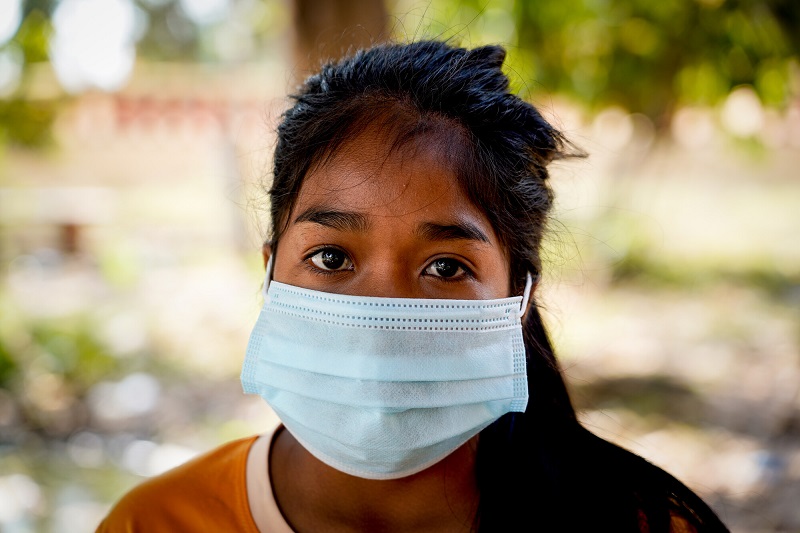
At her community youth center in Bolivia, Fanny, 20, participates in
creating a map of the safe and unsafe places in her neighborhood. Teaching young people how to
protect themselves from violence is an important part of ChildFund’s programming; now that many
children are in ongoing lockdowns, kept home from school and community activities, we are finding
new ways to bring the information to them.
In many
countries around the world, children have returned to school. Classrooms are filled with
excitement and anxiety as teachers and children reconnect after more than a year’s
separation. Parents feel a sense of relief but hesitate to celebrate as possible
infections, quarantines and school closures may again threaten this long-awaited
re-entry into normalcy.
Sadly, an estimated 140 million children will not experience this normalcy, even
temporarily, because they did not return to school this academic year at all. In
addition to disrupting learning, the COVID-19 pandemic has interrupted livelihoods, separated
families and restricted access to basic services, causing significant stress to
caregivers and children alike.
Schooling
plays an important role in children’s social, emotional and cognitive development – but
also in kids’ protection from violence. Disruptions to education not only negatively
affect learning, but they also affect children’s mental and physical health and their
ability to stay safe from harm.
Risks to children kept out of school

“[My friends] say that
school is no more, and that life has ended,” says Oscar, 17. Schools in his community in Uganda
have been closed since March 2020, and the only learning materials he has are the books and
worksheets he receives from ChildFund to study at home. Many children in his community have
given up on school, instead going to work as fishermen on nearby Lake Victoria. “I have lost
close friends who have drowned in the lake,” he says.
Out-of-school children around
the world are at increased risk for engaging in risky behavior like child labor, early
marriage, drug abuse and more. They are also more vulnerable to becoming victims of
abuse and exploitation.
The stress families have experienced during
the pandemic has manifested in a heightened risk of child abuse, neglect and violence against
children in various forms. Children who were already experiencing or
witnessing abuse at home have now been enclosed with those abusive family members,
absent from the view of teachers or other adults who might normally be able to
detect the abuse or identify children at risk and refer them to protection
services.
How to help kids protect themselves
While adults are always
primarily responsible for the protection of children, educating children on how to
become champions of their own safety can reduce their vulnerability and better
equip them to protect themselves and their peers from violence. Simple skills, such as
recognizing a safe or unsafe place or identifying a trusted network of adults in the
community, can prevent or stop violence against children.
ChildFund
is addressing the heightened risk of violence to children globally through a comic book
called Protecting Yourself and Your Friends! The comic book, geared toward
children ages 6 to 12, aims to teach basic self-protection skills and knowledge and help
children become advocates for their own safety.
In Sierra Leone and Uganda, the book will be used
as part of ChildFund’s School-Based Violence Prevention Program, where each
child will have their own copy of the book to accompany a series of 19
lessons. These lessons teach children about the different forms of abuse;
differentiating between good, bad and confusing touches; and the hotlines
they can use to report violence. In countries like Sri Lanka and India, where schools remain fully or
partially closed, ChildFund will disseminate the comic book in print as
part of home-based learning activity packets, as well as via social
media cards. In Sri Lanka, the comic book will also be available on the
Ministry of Education’s distance learning platform.
Protecting
Yourself and Your Friends! will be translated into various other languages and
tested with children in three regions to receive their input. For now, ChildFund is
working with an illustrator to develop additional comic books to help children learn
four critical skills: 1) recognizing child abuse; 2) recognizing safe and unsafe
situations; 3) identifying a network of trusted adults; and 4) knowing when, how, and
where to report incidences of violence against children. The comics will soon be
available for download from the ChildFund website so that children, caregivers and
teachers around the world have access to this valuable information.
As the
COVID-19 pandemic continues to disrupt the lives of children and create an increased
risk of harm, ChildFund’s programs remain committed to supporting children and their
caregivers. We’re working to ensure that children around the world can realize their
rights to education and protection from harm – and, above all, to ensure that children
have the critical skills they need to protect themselves.







